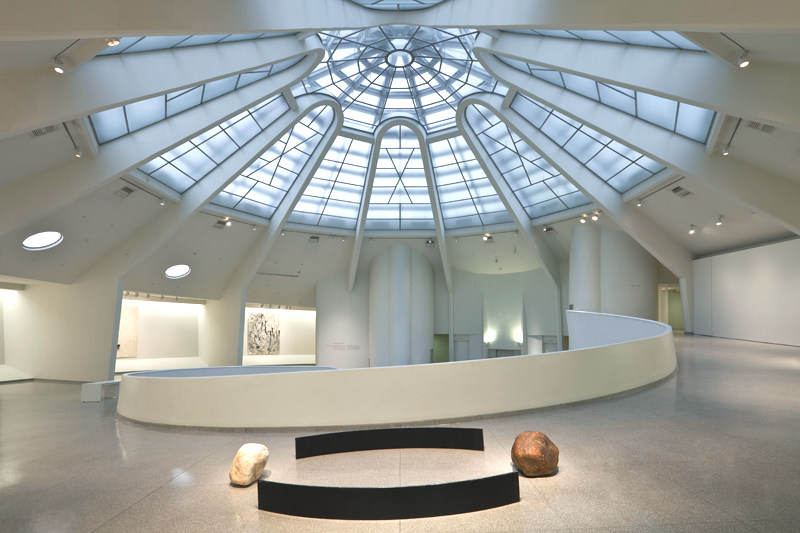For the hot, tired and frazzled masses, the Guggenheim Museum offers an oasis of cool serenity this summer. “Marking Infinity,” a five-decade retrospective of the art of Lee Ufan, fills the museum rotunda and two side galleries with about 90 works in a Zen-Minimalist, be-here-now vein.
National Museum of Modern Art, Kyoto
“From Line,” a 1977 work, is an example of Mr. Lee's making the brush stroke his primary device over the last four decades.
Mr. Lee, 75, is an aesthetic distiller. He boils two- and three-dimensional art down to formal and conceptual essences. Sculptures consist of ordinary, pumpkin-size boulders juxtaposed with sheets and slabs of dark, glossy steel. Paintings made of wide brush strokes executed in gridded order on raw canvas exemplify tension between action and restraint.
A much published philosopher as well as an artist who divides his time between Japan and Paris, Mr. Lee has enjoyed considerable recognition in Europe and in the Far East. Last year the Lee Ufan Museum, a building designed by Tadao Ando, opened on the island of Naoshima, Japan.
But Mr. Lee’s reputation has not extended to the United States. This exhibition, his first in a North American museum, gives a sense of why. His art is impeccably elegant, but in its always near-perfect composure, it teeters between art and décor.
His sculptures call to mind those of Richard Serra, but shy away from the brute physicality of Mr. Serra’s works; his paintings invite comparison to those of Robert Ryman, but are less pragmatically inventive. In its modernization of classical Asian gestures, his work is more suavely stylish than philosophically or spiritually illuminating.
It is interesting to learn, then, from the well-written catalog essay by Alexandra Munroe, who organized the show and is the Guggenheim’s curator of Asian art, what a turbulent environment of art and politics Mr. Lee came out of. He was born in Japanese-occupied Korea in 1936. He studied painting in Seoul and philosophy in Japan, where he moved in 1956.
Steeped in the phenomenology of Merleau-Ponty and Heidegger and in Marxist politics, he became an active participant in the countercultural upheavals of the 1960s. At the end of the decade he was co-founder of an antitraditionalist movement called Mono-ha, which roughly translates as “school of things.”
Examples of Mr. Lee’s Mono-ha works here have an enigmatic, wry wit. A piece from 1969 called “Relatum” (Mr. Lee has used this word in the titles of most of his three-dimensional works) makes his concerns explicit. A length of rubber ribbon marked in centimeters like a tape measure is partly stretched and held down by three stones. A stretchy ruler will give false measurements, but are not all human-made measuring devices similarly fallible? Here was a parable for a time when authoritative representations of truth seemed increasingly unreliable to youthful rebels everywhere.
A work from 1971 consisting of seven found boulders, each resting on a simple square cushion on the floor, foreshadows Mr. Lee’s solution. The pillows add a certain anthropomorphic humor, as if the stones were incarnations of the legendary Seven Sages of the Bamboo Grove, whose minds expanded beyond human limits to embrace geological time. But more important, the seven rocks prompt meditation on our unmediated experience of things in time and space.
The problem is that in a museum setting it is next to impossible to experience stones unclothed by cultural, symbolic associations. We have seen too many rocks used as landscape ornaments and read too many poems about them. Looking at a “Relatum” from 2008, in which a boulder is placed in front of an 80-inch-tall steel plate that leans against the wall, the juxtaposition of nature and culture is too familiar, too formulaic, to be revelatory.
In paintings from the last four decades, Mr. Lee has made the brush stroke his primary device, often to optically gripping and lyrical effect. In the ’70s he pursued two approaches, always using just one color per canvas — usually blue, red or black.
In one series he used a paint-loaded brush to make horizontal rows of squarish marks one after another, each paler than its predecessor, as the paint was used up. He thereby created gridded fields of staccato patterning.
In other paintings he used wide brushes to make long, vertical stripes, dark at the top and fading toward the bottom. They give the impression of stockade fencing obscured near the ground by low-lying fog.
In the ’80s Mr. Lee loosened up his strokes and began to produce airy, monochrome compositions in a kind of Abstract expressionist style driven not by emotional angst but by delight in existential flux. This period culminates at the end of the decade in canvases densely covered by squiggly gray marks that are among the exhibition’s most compelling.
From the mid-’90s on, Mr. Lee pared down his paintings, arriving four years ago at a particular modular form: an oversize brush stroke shaped like a slice of bread and fading from black to pale gray. He uses this device to punctuate sparingly large, otherwise blank, off-white canvases. Here, as with the stone and steel works, preciousness trumps phenomenology.
But something different and more exciting happens in a site-specific work that ends the show. In an approximately square room, Mr. Lee painted one of his gray-black modules directly on each of three walls. A surprising tension between the materiality of the paint and an illusion of space arises. The modules become like television screens or airplane windows, affording views of indefinite, possibly infinite space beyond the museum walls. It makes for a fine wedding of the real and the metaphysical.
“Lee Ufan: Marking Infinity,” runs through Sept. 28 at the Guggenheim Museum, 1071 Fifth Avenue, at 89th Street; (212) 423-3500, guggenheim.org.




